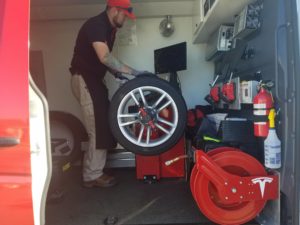Reliable Mobile Tire Change and Replacement in Las Vegas
Reliable Mobile Tire Change and Replacement in Las Vegas
Blog Article
Tire Service: Proven Methods for Optimum Tire Maintenance and Treatment
Maintaining ideal tire condition is vital for both safety and security and efficiency of any lorry. From guaranteeing correct tire pressure to regular turning and alignment, there are tried and tested methods that can considerably expand the life expectancy of your tires and boost overall driving experience. As we explore the details of tire care and upkeep, we will certainly uncover crucial guidelines that every car proprietor should abide by for the very best feasible results. Allow's explore the world of tire service and uncover the secrets to keeping your tires in top-notch shape for the lengthy haul.
Relevance of Tire Stress
Adequate tire pressure advertises better fuel performance, as under-inflated tires can lead to enhanced rolling resistance, triggering the engine to work more challenging and consume even more fuel. Proper tire pressure ensures even walk wear, improving tire longevity and saving money in the lengthy run by postponing the need for premature replacements. Routinely checking and adjusting tire stress, specifically previously lengthy trips, is an easy yet reliable means to enhance lorry efficiency, extend tire lifespan, and prioritize security on the roadway.
Tire Turning Guidelines
When thinking about tire rotation guidelines, it is vital to comprehend the value of this upkeep task in taking full advantage of tire life expectancy and keeping optimum lorry performance. Tire rotation includes altering the position of each tire on a car to guarantee even walk wear. Front tires have a tendency to put on extra promptly than back tires because of steering forces, making regular turning critical for well balanced wear patterns. The advised rotation pattern varies depending upon whether a lorry is front-wheel, rear-wheel, all-wheel, or 4x4. Typically, tires ought to be turned every 5,000 to 7,500 miles, or as encouraged in the automobile handbook. Ignoring tire rotation can result in uneven wear, influencing handling, grip, and potentially compromising lorry safety and security. By sticking to appropriate rotation guidelines, vehicle drivers can expand the life of their tires, enhance gas performance, and improve total driving experience. Regular turning is an easy yet efficient upkeep method that contributes substantially to tire longevity and lorry performance.

Advantages of Wheel Placement
Ensuring correct wheel alignment after tire rotation is vital for keeping balanced wear patterns and maximizing car efficiency. Wheel alignment refers to the modification of the angles of the wheels to the manufacturer's requirements. Among the key benefits of wheel positioning is enhanced guiding and dealing with action. When the wheels are correctly straightened, it decreases steering effort, guaranteeing a smoother and a lot more controlled driving experience. Additionally, right wheel alignment aids to prolong the life-span of your tires. Misaligned wheels can create uneven tire wear, resulting in premature tire replacement and raised maintenance prices.

Tire Footstep Depth Examine
Doing a regular inspection of tire walk deepness is crucial for keeping risk-free driving problems and lengthening the life expectancy of your tires. Uneven step wear can suggest issues with tire positioning, pressure, or suspension, highlighting the relevance of routine tread deepness checks. By incorporating tire walk depth checks right into your routine upkeep schedule, you can drive with self-confidence knowing that your tires are in leading condition.
Seasonal Tire Examination
Seasonal tire evaluation is a basic facet of tire maintenance that ensures tires are all set to encounter the challenges posed by various climate problems. In prep work for winter season, it is important to check the tire stress routinely as cool temperature levels can create tire pressure to go down. By performing routine seasonal tire evaluations, motorists can lengthen tire life-span, enhance gas performance, and most significantly, guarantee a secure driving experience in differing weather condition conditions.
Verdict
In verdict, keeping correct tire pressure, rotating tires routinely, lining up wheels appropriately, monitoring step depth, and performing seasonal visit this page assessments are important techniques for ideal tire care. By complying with these proven approaches, chauffeurs can guarantee their tires last much longer, do better, and add to overall lorry safety. It is vital to focus on tire upkeep to avoid crashes, boost gas efficiency, and extend the life-span of tires.
Ample tire pressure promotes far better fuel effectiveness, as under-inflated tires can lead to increased rolling use this link resistance, creating the engine to work more difficult and take in more gas.When taking into consideration tire rotation standards, it is vital to recognize the importance of this maintenance job in taking full advantage of tire life expectancy and maintaining ideal lorry efficiency. Seasonal tire assessment is an essential aspect of tire upkeep that ensures tires are all set to deal with the obstacles postured by various climate conditions. By conducting routine seasonal tire evaluations, motorists can extend tire life-span, boost gas performance, and most you could try here significantly, guarantee a protected driving experience in varying weather condition problems.
In conclusion, preserving proper tire pressure, revolving tires frequently, lining up wheels appropriately, checking walk deepness, and carrying out seasonal assessments are essential methods for optimum tire treatment.
Report this page